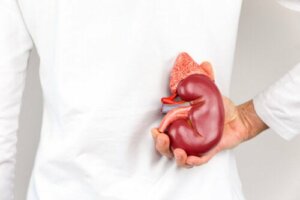Symptoms and Diagnosis of Chronic Kidney Failure


Written and verified by the doctor Leonardo Biolatto
Chronic kidney failure is a gradual process in which these organs stop working properly. You may already know how essential they are as they’re responsible for filtering the blood and excreting waste substances through the urine.
As if that wasn’t enough, they also fulfill hormonal, electrolyte, and metabolic functions. Thus, when the disease progresses and function is irreversibly lost, the situation becomes incompatible with your life if you don’t begin immediate treatment.
This condition is usually asymptomatic in the beginning so reaching a diagnosis can be complex. In today’s article, we’ll explain the symptoms that may appear and how a doctor would diagnose chronic kidney failure.
Symptoms of chronic kidney failure
Chronic kidney failure manifests in many ways and it’s because, as we pointed out above, kidneys fulfill numerous body functions.
Anorexia is one of the most common symptoms and then there’s nausea and vomiting. According to a study published in Revista de Nefrología, these signs are caused by increased urea in the blood. Unfortunately, it can linger even after treatment, increasing the risk of malnutrition.
High blood pressure, fatigue, and trouble sleeping are other common manifestations. There’s general fluid retention when the kidneys stop working and it leads to shortness of breath, leg swelling, and chest pain.

You may be interested in the Management of Chronic Kidney Disease
Electrolyte disturbances
These alterations usually appear when the kidneys are already quite damaged. The electrolytes that are most often affected are baking soda, sodium, and potassium. Potassium tends to rise in the blood, leading to cardiac rhythm disturbances.
Baking soda is essential for regulating the levels of internal acidity in the body. Metabolic acidosis occurs when there’s advanced chronic kidney failure.
Cardiovascular manifestations of chronic renal failure
An article in Anales de Cirugía Cardiaca y Vascular states that kidney failure has similar risk factors as those of cardiovascular disease: being a senior, smoking, and dyslipidemia.
High levels of urea in the blood cause an acceleration of the atherosclerosis process. This consists of the formation of cholesterol plaques in the blood vessels that prevent adequate blood flow. Hence, there’s a higher risk of ischemic heart disease and heart failure, among other problems.
Are you aware of What Your Kidneys Do?
Hematological abnormalities
Anemia is one of the earliest symptoms of this disease. In fact, this disorder also worsens as chronic kidney failure progresses. It’s caused by a deficiency of erythropoietin, a substance synthesized in the kidneys that stimulate the formation of red blood cells.
Osteomuscular disorders due to chronic renal failure
Renal osteodystrophy refers to all skeletal symptoms secondary to kidney disease. Deformities in some bones, such as fingers, and a higher incidence of fractures are common. In addition, bone tissue pain is present in most patients with this condition.
Hormonal changes
There are alterations of a sexual nature in both men and women. According to Clinica de la Universidad de Navarra, females tend to present menstrual alterations while men have erectile dysfunction and present a decrease in sperm count.
Skin problems
Chronic kidney failure also leads to skin changes. In fact, these symptoms appear as a result of hemodialysis treatment. For example, there may be itching, dryness, changes in the hair. Also, anemia causes pale skin.

Diagnosis of chronic kidney failure
Symptoms appear when the disease is already advanced. Therefore, it’s important to conduct a series of tests in order to diagnose the early signs of renal insufficiency.
Firstly, doctors may do a blood test that shows creatinine and urea levels. This is because these are two indicators of kidney function. They may also do a urinalysis in order to quantify the expelled volume in a full day.
Imaging tests such as ultrasound or MRI can complement a diagnosis. Kidneys tend to decrease in size, as does the amount of urine excreted. A physician can record this via imaging.
A complex disease
Chronic kidney failure is a complex disease you must treat as efficiently as possible, depending on the available resources. Usually, hemodialysis is the technique of choice but you must keep in mind it influences many aspects of your body.
Similarly, smoking increases the risk posed by this disease and also your chances of both cardiovascular and kidney complications. This is why it’s essential to take it into account.
You must follow the nephrologist’s recommendations in regard to its care and treatment approach. This is because your quality of life depends on these indications as well as in your observance of a specific diet and changes in your lifestyle.
We hope you’ve enjoyed this article.
All cited sources were thoroughly reviewed by our team to ensure their quality, reliability, currency, and validity. The bibliography of this article was considered reliable and of academic or scientific accuracy.
- Insuficiencia renal crónica: Síntomas, diagnóstico y tratamiento. CUN. (n.d.). Retrieved September 5, 2020, from https://www.cun.es/enfermedades-tratamientos/enfermedades/insuficiencia-renal-cronica
- Insuficiencia renal crónica. (n.d.). Retrieved September 5, 2020, from http://www.scielo.org.pe/scielo.php?pid=s1018-130×2003000100001&script=sci_arttext
- Cabo, H., Donatti, L., Allevatto, M., Ferro, M., Ledesma, C., Pastorale, P., … Woscoff, A. (1996). Manifestaciones cutáneas en pacientes dializados por insuficiencia renal crónica. Dermatol. Argent, 2(4), 307–311.
- Puigvert Barcelona, F., -, C., & -e, H. H. (2004). Enrique Andrés Ribes Servicio de Nefrología. Anales de Cirugía Cardíaca y Vascular (Vol. 10).
- La anorexia urémica. | Nefrología. (n.d.). Retrieved September 5, 2020, from https://www.revistanefrologia.com/es-la-anorexia-uremica–articulo-X0211699598010631
- González, Verónica Benítez. “Enfermedad renal oculta en adultos con hipertensión arterial.” Revista Virtual de la Sociedad Paraguaya de Medicina Interna (2018): 36-41.
- Cohen-Solal, M., and P. Ureña-Torres. “Fragilidad ósea e insuficiencia renal.” EMC-Aparato Locomotor 53.1 (2020): 1-9.
- Vernaza Guerra, Cristina Paola. Variabilidad biológica intra-individual e inter-individual de calcio total, urea y creatinina en pacientes adultos con insuficiencia renal crónica pre-diálisis y post-diálisis. Quito-Ecuador. BS thesis. Quito: UCE, 2018.
- de Mier, MV Pendón Ruiz, et al. “Protocolo diagnóstico de la insuficiencia renal crónica.” Medicine-Programa de Formación Médica Continuada Acreditado 12.79 (2019): 4702-4704.
- Mojena-Roblejo, Maricelis, et al. “Complicaciones más frecuentes en pacientes con insuficiencia renal crónica terminal sometidos a hemodiálisis.” Revista Electrónica Dr. Zoilo E. Marinello Vidaurreta 43.3 (2018).
- De Rosa, Graciela, Roberto Ocariz, and Florencia von Stecher. “Tabaquismo y glomeruloesclerosis.” Revista de Nefrología, Diálisis y Trasplante 36.4 (2016): 241-245.
This text is provided for informational purposes only and does not replace consultation with a professional. If in doubt, consult your specialist.








